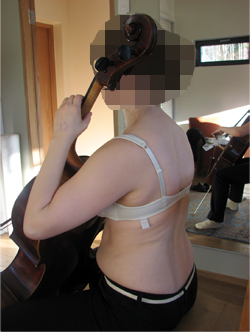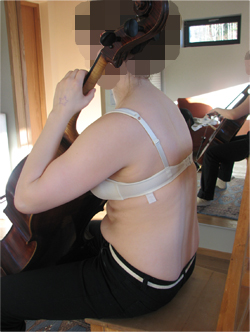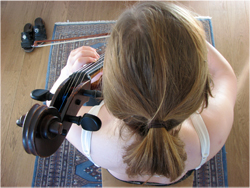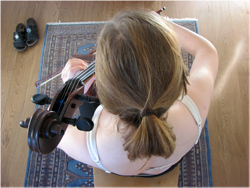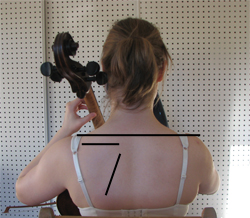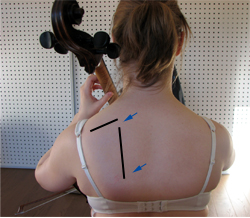Cello - harjoittelu
Cello
Read the Ergonomics Overview first.
The cellist's pelvis and spine should be in the centre position, while allowing for free movement during playing. Movements start from and end in the centre position. In other words, the centre position is the musician's basic position to which he or she always returns. In the centre position, the spine maintains its natural curves. Spinal curves vary between individuals; in the centre position, the backs and hips of different people may look different.
When the pelvis is in the centre position, the ischia point directly downwards, against the seat of the chair. If the chair is too low, the pelvic centre position is difficult to maintain. Therefore, checking and adjusting the seat height should be a priority for cellists. The seat height should be such that the feet are firmly on the ground, the pelvis stays in the centre position (without exertion), and the back muscles are engaged but not too tense. The seat height always depends on the individual, as the flexibility of the pelvic region varies from one person to another. Some can sit on a low chair with minimal muscular effort, while others with a stiffer pelvic area need a higher chair.
|
The pelvis and the spine are in the centre position; the shoulder blades are well supported and in a vertical position against the rib cage. |
The pelvis tilts backwards and the whole spine is curved forward; the head pushes forward, the shoulder blades curve forward with the rib cage, resulting in poor support for the shoulder blades. |
The cello spike should be adjusted so that the musician can maintain the centre position of the pelvis and the spine. If the instrument sits too low, the musician's back starts to curve easily. During playing, the cellist's spine is prone to twisting to the left. The twist increases when the bow is moved to the A string, or when the left hand moves up the fingerboard and to the A string. If the spine twists to the left, supporting the left shoulder blade against the ribs becomes more difficult, increasing the strain on the arm and the fingers. It is important to return the spine to the centre position whenever possible and not remain in the twisted position.
|
The body is straight and the shoulder blades are well supported against the rib cage. |
The body twists to the left, causing the left shoulder blade to wing off of the rib cage and turn towards the spine. In this position, control of the left hand is affected. |
For cellists, a typical faulty position of the shoulder blades involves tilting forward the top edge of the shoulder blade, dropping the shoulder blade, and rotating the medial inferior angle (bottom corner) inward (towards the spine). This position exposes the shoulder joints to strain injuries and closes up the superior thoracic outlet area, aperture (the area between the shoulder blade, collarbone and spine, where the veins and nerves leading to the hand run). Both the nerve problems of the hands and poor left-hand vibrato are almost always caused by this faulty position of the shoulder blade.
|
The shoulder blade support muscles function well, and the medial inferior angle (bottom corner) rotates outward. The left wrist remains in a natural position, with the thumb open and fingers moving freely. |
The shoulder blade has insufficient support; it falls and cannot rotate outward, the shoulder drops. |
The hand arches need to be maintained during playing to ensure that the fingers function in the best possible way. If the metacarpal bones drop, the palmar muscles cannot function properly, and there is more strain on the long muscles that move the fingers and extend across the wrist. The wrist should be maintained in the centre position (extended by 15 degrees and tilted towards the little finger by 15 degrees) whenever possible. A statically bent wrist increases the strain on the forearm muscles. Problems in the wrist, thumb and forearm are relatively common for cellists, and they are often caused by insufficient muscular support of the thumb and excessive bending of the wrist. In order to correct the hand position, the musician needs exercises to strengthen and activate the support muscles in the palm and the fingers.

